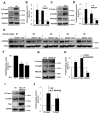An SCFFBXO28 E3 Ligase Protects Pancreatic β-Cells from Apoptosis
- PMID: 29587369
- PMCID: PMC5979299
- DOI: 10.3390/ijms19040975
An SCFFBXO28 E3 Ligase Protects Pancreatic β-Cells from Apoptosis
Abstract
Loss of pancreatic β-cell function and/or mass is a central hallmark of all forms of diabetes but its molecular basis is incompletely understood. β-cell apoptosis contributes to the reduced β-cell mass in diabetes. Therefore, the identification of important signaling molecules that promote β-cell survival in diabetes could lead to a promising therapeutic intervention to block β-cell decline during development and progression of diabetes. In the present study, we identified F-box protein 28 (FBXO28), a substrate-recruiting component of the Skp1-Cul1-F-box (SCF) ligase complex, as a regulator of pancreatic β-cell survival. FBXO28 was down-regulated in β-cells and in isolated human islets under diabetic conditions. Consistently, genetic silencing of FBXO28 impaired β-cell survival, and restoration of FBXO28 protected β-cells from the harmful effects of the diabetic milieu. Although FBXO28 expression positively correlated with β-cell transcription factor NEUROD1 and FBXO28 depletion also reduced insulin mRNA expression, neither FBXO28 overexpression nor depletion had any significant impact on insulin content, glucose-stimulated insulin secretion (GSIS) or on other genes involved in glucose sensing and metabolism or on important β-cell transcription factors in isolated human islets. Consistently, FBXO28 overexpression did not further alter insulin content and GSIS in freshly isolated islets from patients with type 2 diabetes (T2D). Our data show that FBXO28 improves pancreatic β-cell survival under diabetogenic conditions without affecting insulin secretion, and its restoration may be a novel therapeutic tool to promote β-cell survival in diabetes.
Keywords: E3 ligase; FBXO28; NeuroD1; apoptosis; diabetes; human islet; insulin secretion; pancreatic β-cell.
Conflict of interest statement
The authors declare no conflict of interest.
Figures




Similar articles
-
SCFFBXO28-mediated self-ubiquitination of FBXO28 promotes its degradation.Cell Signal. 2020 Jan;65:109440. doi: 10.1016/j.cellsig.2019.109440. Epub 2019 Oct 31. Cell Signal. 2020. PMID: 31678254
-
Circulating LncRNAs Analysis in Patients with Type 2 Diabetes Reveals Novel Genes Influencing Glucose Metabolism and Islet β-Cell Function.Cell Physiol Biochem. 2018;46(1):335-350. doi: 10.1159/000488434. Epub 2018 Mar 22. Cell Physiol Biochem. 2018. PMID: 29590649
-
CDK-mediated activation of the SCF(FBXO) (28) ubiquitin ligase promotes MYC-driven transcription and tumourigenesis and predicts poor survival in breast cancer.EMBO Mol Med. 2013 Jul;5(7):1067-86. doi: 10.1002/emmm.201202341. Epub 2013 Jun 14. EMBO Mol Med. 2013. PMID: 23776131 Free PMC article.
-
The pancreatic beta-cell in human Type 2 diabetes.Nutr Metab Cardiovasc Dis. 2006 Mar;16 Suppl 1:S3-6. doi: 10.1016/j.numecd.2005.10.017. Epub 2006 Feb 9. Nutr Metab Cardiovasc Dis. 2006. PMID: 16530127 Review.
-
[Regulation of Lipid Metabolism by Diacylglycerol Kinases in Pancreatic β-cells].Yakugaku Zasshi. 2016;136(3):461-5. doi: 10.1248/yakushi.15-00246-1. Yakugaku Zasshi. 2016. PMID: 26935087 Review. Japanese.
Cited by
-
FBXO28 reduces high-fat diet-induced hyperlipidemia in mice by alleviating abnormal lipid metabolism and inflammatory responses.J Endocrinol Invest. 2024 Nov;47(11):2757-2774. doi: 10.1007/s40618-024-02376-5. Epub 2024 May 2. J Endocrinol Invest. 2024. PMID: 38696123
-
FBXO28 promotes proliferation, invasion, and metastasis of pancreatic cancer cells through regulation of SMARCC2 ubiquitination.Aging (Albany NY). 2023 Jun 21;15(12):5381-5398. doi: 10.18632/aging.204780. Epub 2023 Jun 21. Aging (Albany NY). 2023. PMID: 37348029 Free PMC article.
-
The Influences of Perinatal Androgenic Exposure on Cardiovascular and Metabolic Disease of Offspring of PCOS.Reprod Sci. 2023 Nov;30(11):3179-3189. doi: 10.1007/s43032-023-01286-w. Epub 2023 Jun 28. Reprod Sci. 2023. PMID: 37380913 Review.
-
SKP1-CUL1-F-box: Key molecular targets affecting disease progression.FASEB J. 2025 Jan 31;39(2):e70326. doi: 10.1096/fj.202402816RR. FASEB J. 2025. PMID: 39812503 Free PMC article. Review.
-
FBXO28 promotes cell proliferation, migration and invasion via upregulation of the TGF-beta1/SMAD2/3 signaling pathway in ovarian cancer.BMC Cancer. 2024 Jan 24;24(1):122. doi: 10.1186/s12885-024-11893-8. BMC Cancer. 2024. PMID: 38267923 Free PMC article.
References
MeSH terms
Substances
LinkOut - more resources
Full Text Sources
Other Literature Sources
Medical

